Analysis of Gender in Monitoring and Evaluation Programs
VerifiedAdded on 2021/05/31
|8
|1779
|98
Report
AI Summary
This report provides a comprehensive analysis of gender in monitoring and evaluation, emphasizing its critical role in assessing the impact of programs on both men and women, and its contribution to addressing gender inequality. It explores the use of quantitative, qualitative, and mixed methods for...
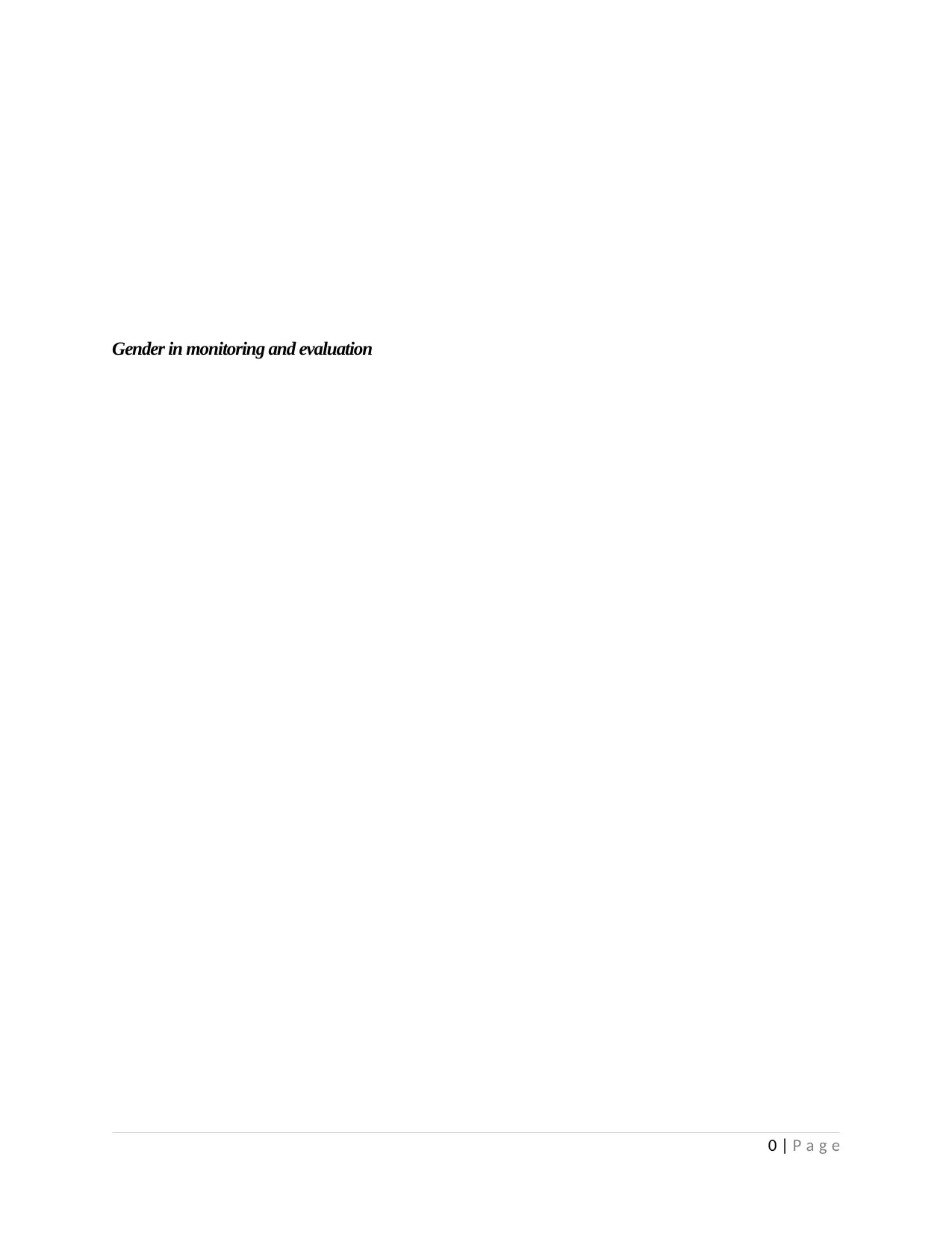
Gender in monitoring and evaluation
0 | P a g e
0 | P a g e
Paraphrase This Document
Need a fresh take? Get an instant paraphrase of this document with our AI Paraphraser
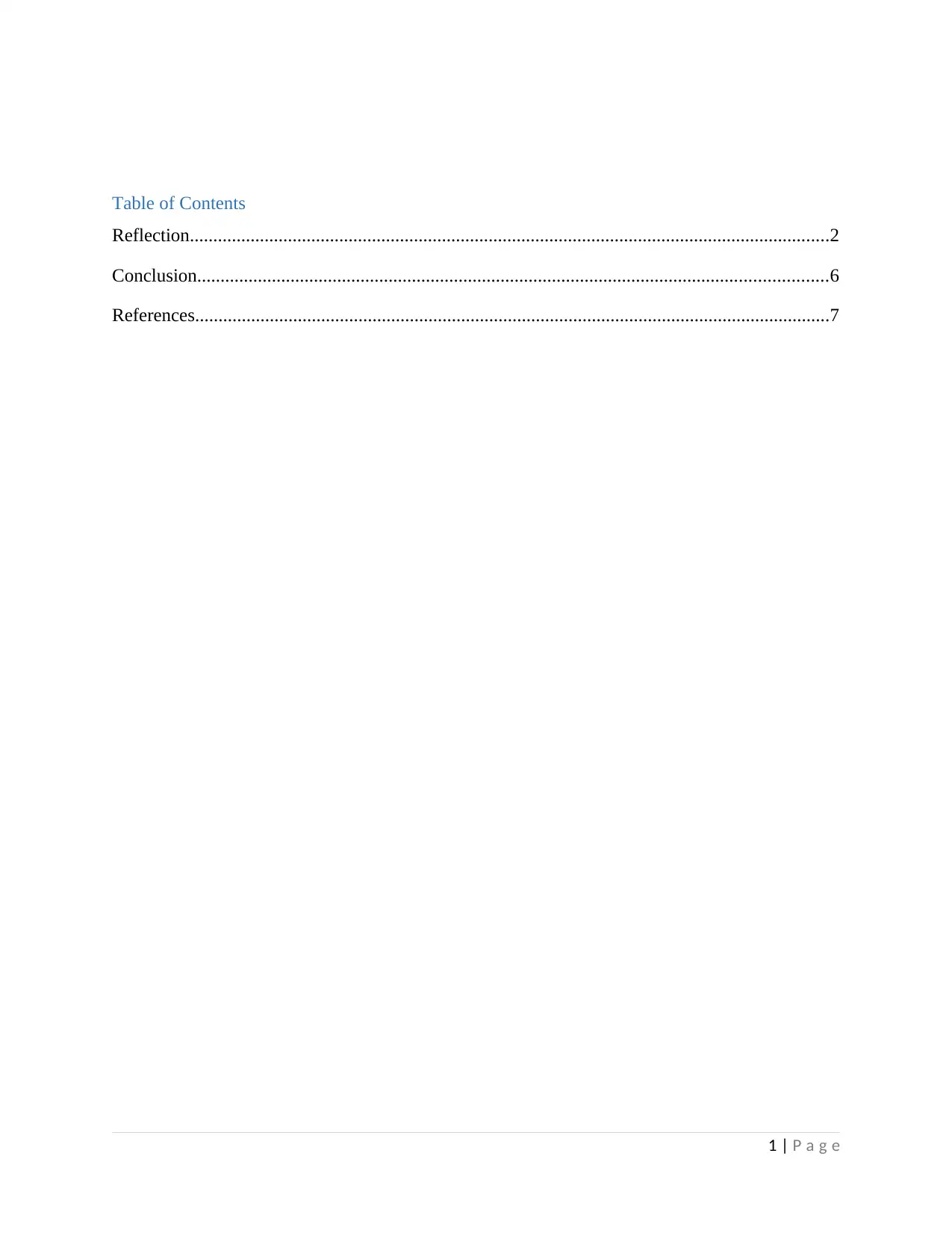
Table of Contents
Reflection.........................................................................................................................................2
Conclusion.......................................................................................................................................6
References........................................................................................................................................7
1 | P a g e
Reflection.........................................................................................................................................2
Conclusion.......................................................................................................................................6
References........................................................................................................................................7
1 | P a g e
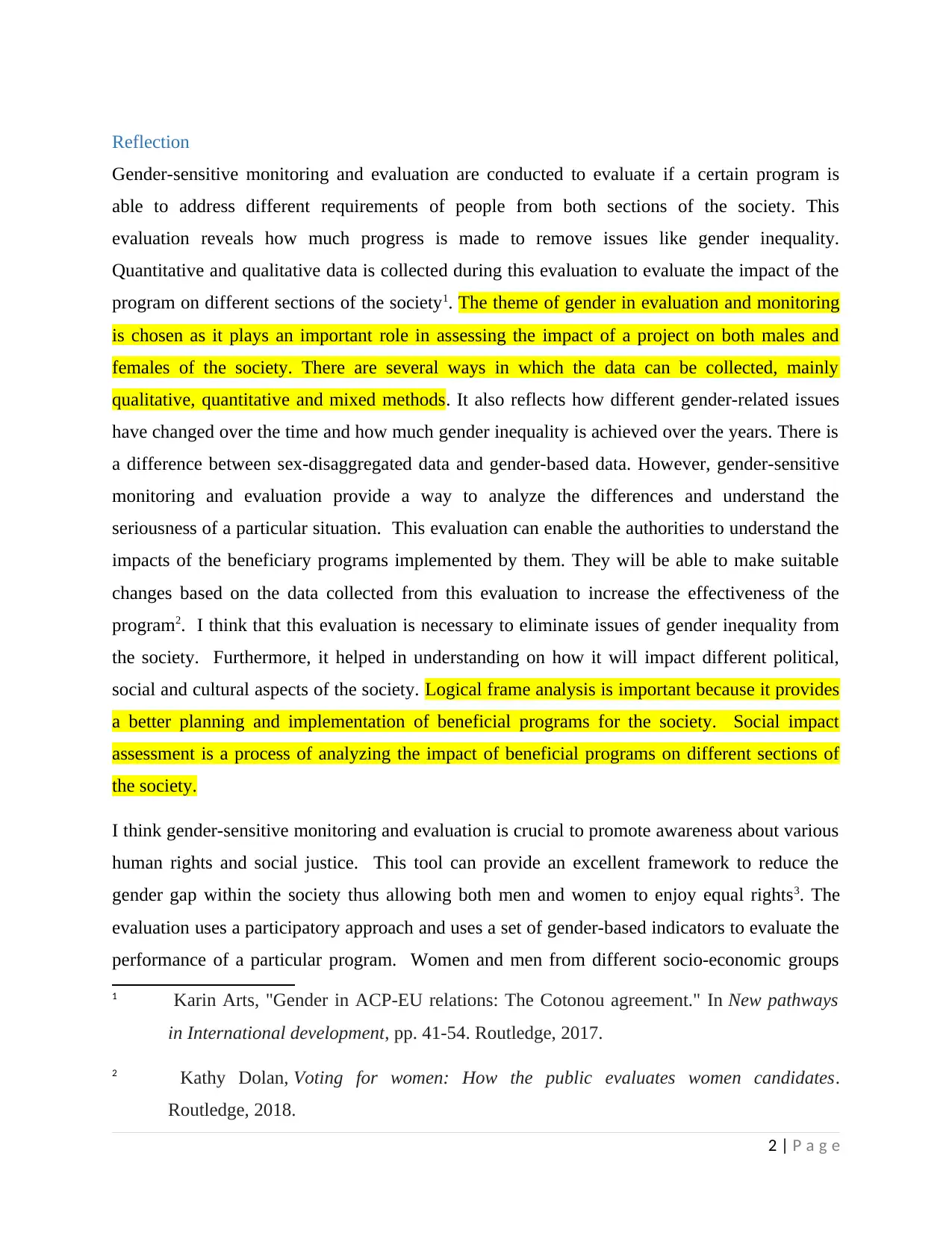
Reflection
Gender-sensitive monitoring and evaluation are conducted to evaluate if a certain program is
able to address different requirements of people from both sections of the society. This
evaluation reveals how much progress is made to remove issues like gender inequality.
Quantitative and qualitative data is collected during this evaluation to evaluate the impact of the
program on different sections of the society1. The theme of gender in evaluation and monitoring
is chosen as it plays an important role in assessing the impact of a project on both males and
females of the society. There are several ways in which the data can be collected, mainly
qualitative, quantitative and mixed methods. It also reflects how different gender-related issues
have changed over the time and how much gender inequality is achieved over the years. There is
a difference between sex-disaggregated data and gender-based data. However, gender-sensitive
monitoring and evaluation provide a way to analyze the differences and understand the
seriousness of a particular situation. This evaluation can enable the authorities to understand the
impacts of the beneficiary programs implemented by them. They will be able to make suitable
changes based on the data collected from this evaluation to increase the effectiveness of the
program2. I think that this evaluation is necessary to eliminate issues of gender inequality from
the society. Furthermore, it helped in understanding on how it will impact different political,
social and cultural aspects of the society. Logical frame analysis is important because it provides
a better planning and implementation of beneficial programs for the society. Social impact
assessment is a process of analyzing the impact of beneficial programs on different sections of
the society.
I think gender-sensitive monitoring and evaluation is crucial to promote awareness about various
human rights and social justice. This tool can provide an excellent framework to reduce the
gender gap within the society thus allowing both men and women to enjoy equal rights3. The
evaluation uses a participatory approach and uses a set of gender-based indicators to evaluate the
performance of a particular program. Women and men from different socio-economic groups
1 Karin Arts, "Gender in ACP-EU relations: The Cotonou agreement." In New pathways
in International development, pp. 41-54. Routledge, 2017.
2 Kathy Dolan, Voting for women: How the public evaluates women candidates.
Routledge, 2018.
2 | P a g e
Gender-sensitive monitoring and evaluation are conducted to evaluate if a certain program is
able to address different requirements of people from both sections of the society. This
evaluation reveals how much progress is made to remove issues like gender inequality.
Quantitative and qualitative data is collected during this evaluation to evaluate the impact of the
program on different sections of the society1. The theme of gender in evaluation and monitoring
is chosen as it plays an important role in assessing the impact of a project on both males and
females of the society. There are several ways in which the data can be collected, mainly
qualitative, quantitative and mixed methods. It also reflects how different gender-related issues
have changed over the time and how much gender inequality is achieved over the years. There is
a difference between sex-disaggregated data and gender-based data. However, gender-sensitive
monitoring and evaluation provide a way to analyze the differences and understand the
seriousness of a particular situation. This evaluation can enable the authorities to understand the
impacts of the beneficiary programs implemented by them. They will be able to make suitable
changes based on the data collected from this evaluation to increase the effectiveness of the
program2. I think that this evaluation is necessary to eliminate issues of gender inequality from
the society. Furthermore, it helped in understanding on how it will impact different political,
social and cultural aspects of the society. Logical frame analysis is important because it provides
a better planning and implementation of beneficial programs for the society. Social impact
assessment is a process of analyzing the impact of beneficial programs on different sections of
the society.
I think gender-sensitive monitoring and evaluation is crucial to promote awareness about various
human rights and social justice. This tool can provide an excellent framework to reduce the
gender gap within the society thus allowing both men and women to enjoy equal rights3. The
evaluation uses a participatory approach and uses a set of gender-based indicators to evaluate the
performance of a particular program. Women and men from different socio-economic groups
1 Karin Arts, "Gender in ACP-EU relations: The Cotonou agreement." In New pathways
in International development, pp. 41-54. Routledge, 2017.
2 Kathy Dolan, Voting for women: How the public evaluates women candidates.
Routledge, 2018.
2 | P a g e
⊘ This is a preview!⊘
Do you want full access?
Subscribe today to unlock all pages.

Trusted by 1+ million students worldwide
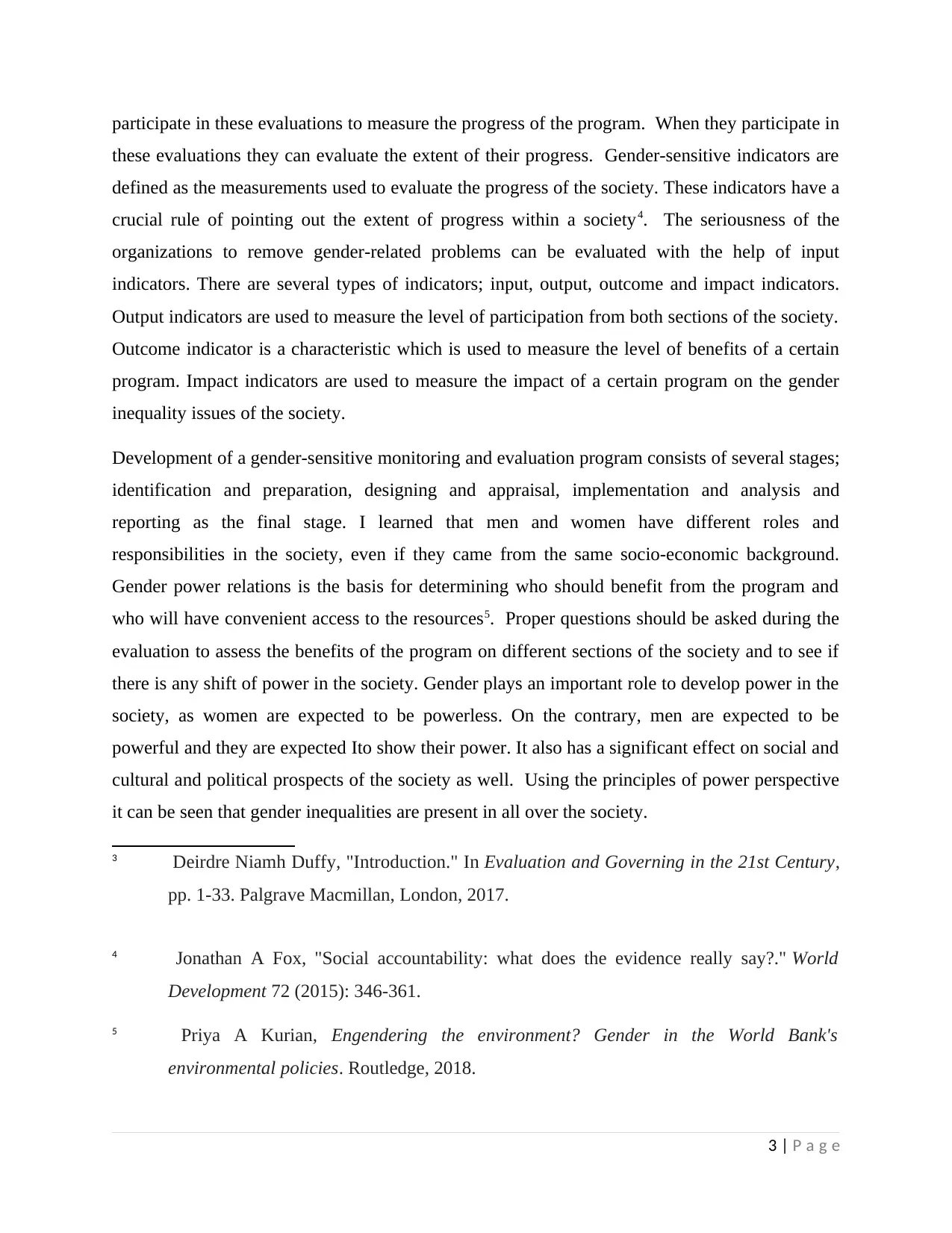
participate in these evaluations to measure the progress of the program. When they participate in
these evaluations they can evaluate the extent of their progress. Gender-sensitive indicators are
defined as the measurements used to evaluate the progress of the society. These indicators have a
crucial rule of pointing out the extent of progress within a society4. The seriousness of the
organizations to remove gender-related problems can be evaluated with the help of input
indicators. There are several types of indicators; input, output, outcome and impact indicators.
Output indicators are used to measure the level of participation from both sections of the society.
Outcome indicator is a characteristic which is used to measure the level of benefits of a certain
program. Impact indicators are used to measure the impact of a certain program on the gender
inequality issues of the society.
Development of a gender-sensitive monitoring and evaluation program consists of several stages;
identification and preparation, designing and appraisal, implementation and analysis and
reporting as the final stage. I learned that men and women have different roles and
responsibilities in the society, even if they came from the same socio-economic background.
Gender power relations is the basis for determining who should benefit from the program and
who will have convenient access to the resources5. Proper questions should be asked during the
evaluation to assess the benefits of the program on different sections of the society and to see if
there is any shift of power in the society. Gender plays an important role to develop power in the
society, as women are expected to be powerless. On the contrary, men are expected to be
powerful and they are expected Ito show their power. It also has a significant effect on social and
cultural and political prospects of the society as well. Using the principles of power perspective
it can be seen that gender inequalities are present in all over the society.
3 Deirdre Niamh Duffy, "Introduction." In Evaluation and Governing in the 21st Century,
pp. 1-33. Palgrave Macmillan, London, 2017.
4 Jonathan A Fox, "Social accountability: what does the evidence really say?." World
Development 72 (2015): 346-361.
5 Priya A Kurian, Engendering the environment? Gender in the World Bank's
environmental policies. Routledge, 2018.
3 | P a g e
these evaluations they can evaluate the extent of their progress. Gender-sensitive indicators are
defined as the measurements used to evaluate the progress of the society. These indicators have a
crucial rule of pointing out the extent of progress within a society4. The seriousness of the
organizations to remove gender-related problems can be evaluated with the help of input
indicators. There are several types of indicators; input, output, outcome and impact indicators.
Output indicators are used to measure the level of participation from both sections of the society.
Outcome indicator is a characteristic which is used to measure the level of benefits of a certain
program. Impact indicators are used to measure the impact of a certain program on the gender
inequality issues of the society.
Development of a gender-sensitive monitoring and evaluation program consists of several stages;
identification and preparation, designing and appraisal, implementation and analysis and
reporting as the final stage. I learned that men and women have different roles and
responsibilities in the society, even if they came from the same socio-economic background.
Gender power relations is the basis for determining who should benefit from the program and
who will have convenient access to the resources5. Proper questions should be asked during the
evaluation to assess the benefits of the program on different sections of the society and to see if
there is any shift of power in the society. Gender plays an important role to develop power in the
society, as women are expected to be powerless. On the contrary, men are expected to be
powerful and they are expected Ito show their power. It also has a significant effect on social and
cultural and political prospects of the society as well. Using the principles of power perspective
it can be seen that gender inequalities are present in all over the society.
3 Deirdre Niamh Duffy, "Introduction." In Evaluation and Governing in the 21st Century,
pp. 1-33. Palgrave Macmillan, London, 2017.
4 Jonathan A Fox, "Social accountability: what does the evidence really say?." World
Development 72 (2015): 346-361.
5 Priya A Kurian, Engendering the environment? Gender in the World Bank's
environmental policies. Routledge, 2018.
3 | P a g e
Paraphrase This Document
Need a fresh take? Get an instant paraphrase of this document with our AI Paraphraser
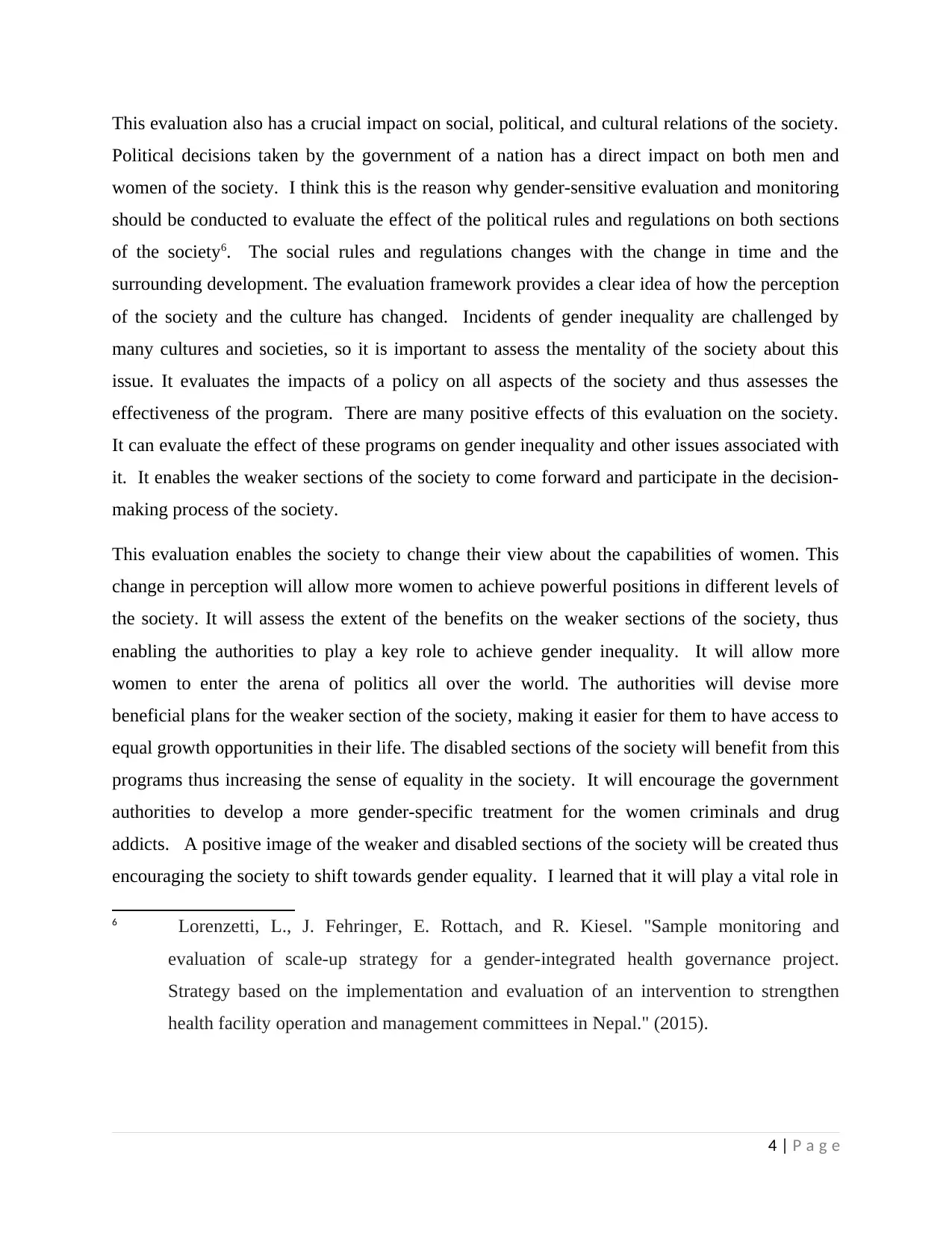
This evaluation also has a crucial impact on social, political, and cultural relations of the society.
Political decisions taken by the government of a nation has a direct impact on both men and
women of the society. I think this is the reason why gender-sensitive evaluation and monitoring
should be conducted to evaluate the effect of the political rules and regulations on both sections
of the society6. The social rules and regulations changes with the change in time and the
surrounding development. The evaluation framework provides a clear idea of how the perception
of the society and the culture has changed. Incidents of gender inequality are challenged by
many cultures and societies, so it is important to assess the mentality of the society about this
issue. It evaluates the impacts of a policy on all aspects of the society and thus assesses the
effectiveness of the program. There are many positive effects of this evaluation on the society.
It can evaluate the effect of these programs on gender inequality and other issues associated with
it. It enables the weaker sections of the society to come forward and participate in the decision-
making process of the society.
This evaluation enables the society to change their view about the capabilities of women. This
change in perception will allow more women to achieve powerful positions in different levels of
the society. It will assess the extent of the benefits on the weaker sections of the society, thus
enabling the authorities to play a key role to achieve gender inequality. It will allow more
women to enter the arena of politics all over the world. The authorities will devise more
beneficial plans for the weaker section of the society, making it easier for them to have access to
equal growth opportunities in their life. The disabled sections of the society will benefit from this
programs thus increasing the sense of equality in the society. It will encourage the government
authorities to develop a more gender-specific treatment for the women criminals and drug
addicts. A positive image of the weaker and disabled sections of the society will be created thus
encouraging the society to shift towards gender equality. I learned that it will play a vital role in
6 Lorenzetti, L., J. Fehringer, E. Rottach, and R. Kiesel. "Sample monitoring and
evaluation of scale-up strategy for a gender-integrated health governance project.
Strategy based on the implementation and evaluation of an intervention to strengthen
health facility operation and management committees in Nepal." (2015).
4 | P a g e
Political decisions taken by the government of a nation has a direct impact on both men and
women of the society. I think this is the reason why gender-sensitive evaluation and monitoring
should be conducted to evaluate the effect of the political rules and regulations on both sections
of the society6. The social rules and regulations changes with the change in time and the
surrounding development. The evaluation framework provides a clear idea of how the perception
of the society and the culture has changed. Incidents of gender inequality are challenged by
many cultures and societies, so it is important to assess the mentality of the society about this
issue. It evaluates the impacts of a policy on all aspects of the society and thus assesses the
effectiveness of the program. There are many positive effects of this evaluation on the society.
It can evaluate the effect of these programs on gender inequality and other issues associated with
it. It enables the weaker sections of the society to come forward and participate in the decision-
making process of the society.
This evaluation enables the society to change their view about the capabilities of women. This
change in perception will allow more women to achieve powerful positions in different levels of
the society. It will assess the extent of the benefits on the weaker sections of the society, thus
enabling the authorities to play a key role to achieve gender inequality. It will allow more
women to enter the arena of politics all over the world. The authorities will devise more
beneficial plans for the weaker section of the society, making it easier for them to have access to
equal growth opportunities in their life. The disabled sections of the society will benefit from this
programs thus increasing the sense of equality in the society. It will encourage the government
authorities to develop a more gender-specific treatment for the women criminals and drug
addicts. A positive image of the weaker and disabled sections of the society will be created thus
encouraging the society to shift towards gender equality. I learned that it will play a vital role in
6 Lorenzetti, L., J. Fehringer, E. Rottach, and R. Kiesel. "Sample monitoring and
evaluation of scale-up strategy for a gender-integrated health governance project.
Strategy based on the implementation and evaluation of an intervention to strengthen
health facility operation and management committees in Nepal." (2015).
4 | P a g e
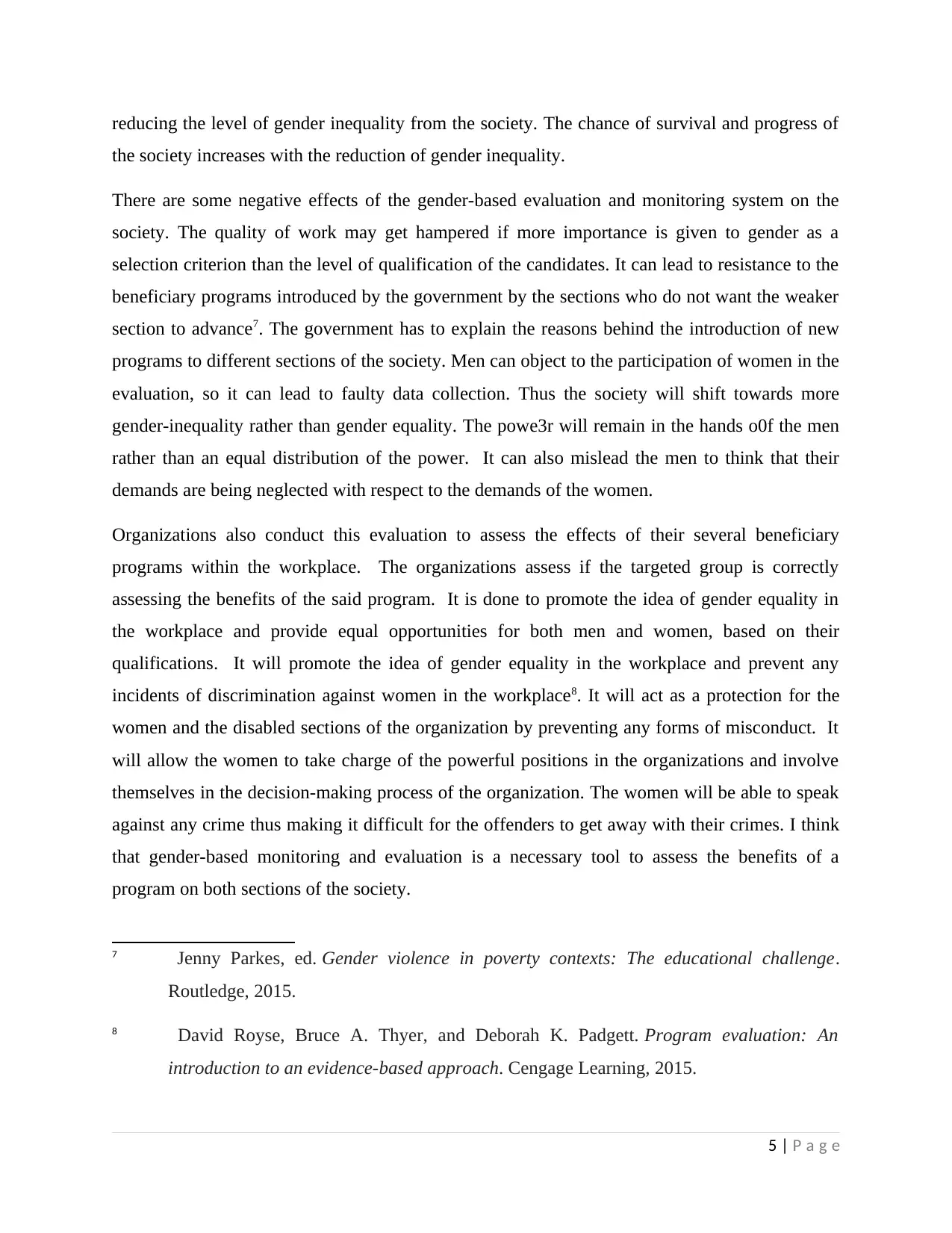
reducing the level of gender inequality from the society. The chance of survival and progress of
the society increases with the reduction of gender inequality.
There are some negative effects of the gender-based evaluation and monitoring system on the
society. The quality of work may get hampered if more importance is given to gender as a
selection criterion than the level of qualification of the candidates. It can lead to resistance to the
beneficiary programs introduced by the government by the sections who do not want the weaker
section to advance7. The government has to explain the reasons behind the introduction of new
programs to different sections of the society. Men can object to the participation of women in the
evaluation, so it can lead to faulty data collection. Thus the society will shift towards more
gender-inequality rather than gender equality. The powe3r will remain in the hands o0f the men
rather than an equal distribution of the power. It can also mislead the men to think that their
demands are being neglected with respect to the demands of the women.
Organizations also conduct this evaluation to assess the effects of their several beneficiary
programs within the workplace. The organizations assess if the targeted group is correctly
assessing the benefits of the said program. It is done to promote the idea of gender equality in
the workplace and provide equal opportunities for both men and women, based on their
qualifications. It will promote the idea of gender equality in the workplace and prevent any
incidents of discrimination against women in the workplace8. It will act as a protection for the
women and the disabled sections of the organization by preventing any forms of misconduct. It
will allow the women to take charge of the powerful positions in the organizations and involve
themselves in the decision-making process of the organization. The women will be able to speak
against any crime thus making it difficult for the offenders to get away with their crimes. I think
that gender-based monitoring and evaluation is a necessary tool to assess the benefits of a
program on both sections of the society.
7 Jenny Parkes, ed. Gender violence in poverty contexts: The educational challenge.
Routledge, 2015.
8 David Royse, Bruce A. Thyer, and Deborah K. Padgett. Program evaluation: An
introduction to an evidence-based approach. Cengage Learning, 2015.
5 | P a g e
the society increases with the reduction of gender inequality.
There are some negative effects of the gender-based evaluation and monitoring system on the
society. The quality of work may get hampered if more importance is given to gender as a
selection criterion than the level of qualification of the candidates. It can lead to resistance to the
beneficiary programs introduced by the government by the sections who do not want the weaker
section to advance7. The government has to explain the reasons behind the introduction of new
programs to different sections of the society. Men can object to the participation of women in the
evaluation, so it can lead to faulty data collection. Thus the society will shift towards more
gender-inequality rather than gender equality. The powe3r will remain in the hands o0f the men
rather than an equal distribution of the power. It can also mislead the men to think that their
demands are being neglected with respect to the demands of the women.
Organizations also conduct this evaluation to assess the effects of their several beneficiary
programs within the workplace. The organizations assess if the targeted group is correctly
assessing the benefits of the said program. It is done to promote the idea of gender equality in
the workplace and provide equal opportunities for both men and women, based on their
qualifications. It will promote the idea of gender equality in the workplace and prevent any
incidents of discrimination against women in the workplace8. It will act as a protection for the
women and the disabled sections of the organization by preventing any forms of misconduct. It
will allow the women to take charge of the powerful positions in the organizations and involve
themselves in the decision-making process of the organization. The women will be able to speak
against any crime thus making it difficult for the offenders to get away with their crimes. I think
that gender-based monitoring and evaluation is a necessary tool to assess the benefits of a
program on both sections of the society.
7 Jenny Parkes, ed. Gender violence in poverty contexts: The educational challenge.
Routledge, 2015.
8 David Royse, Bruce A. Thyer, and Deborah K. Padgett. Program evaluation: An
introduction to an evidence-based approach. Cengage Learning, 2015.
5 | P a g e
⊘ This is a preview!⊘
Do you want full access?
Subscribe today to unlock all pages.

Trusted by 1+ million students worldwide
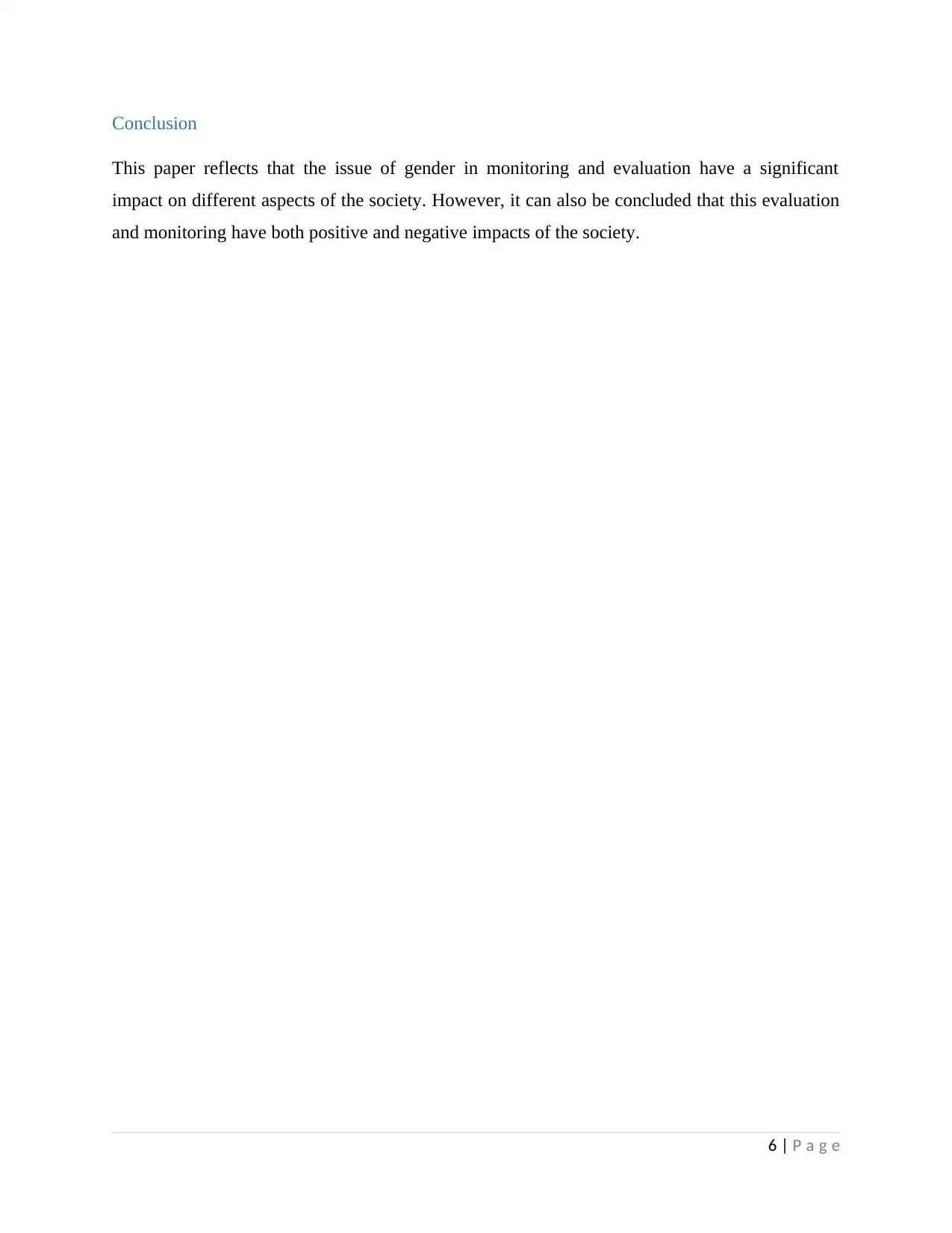
Conclusion
This paper reflects that the issue of gender in monitoring and evaluation have a significant
impact on different aspects of the society. However, it can also be concluded that this evaluation
and monitoring have both positive and negative impacts of the society.
6 | P a g e
This paper reflects that the issue of gender in monitoring and evaluation have a significant
impact on different aspects of the society. However, it can also be concluded that this evaluation
and monitoring have both positive and negative impacts of the society.
6 | P a g e
Paraphrase This Document
Need a fresh take? Get an instant paraphrase of this document with our AI Paraphraser
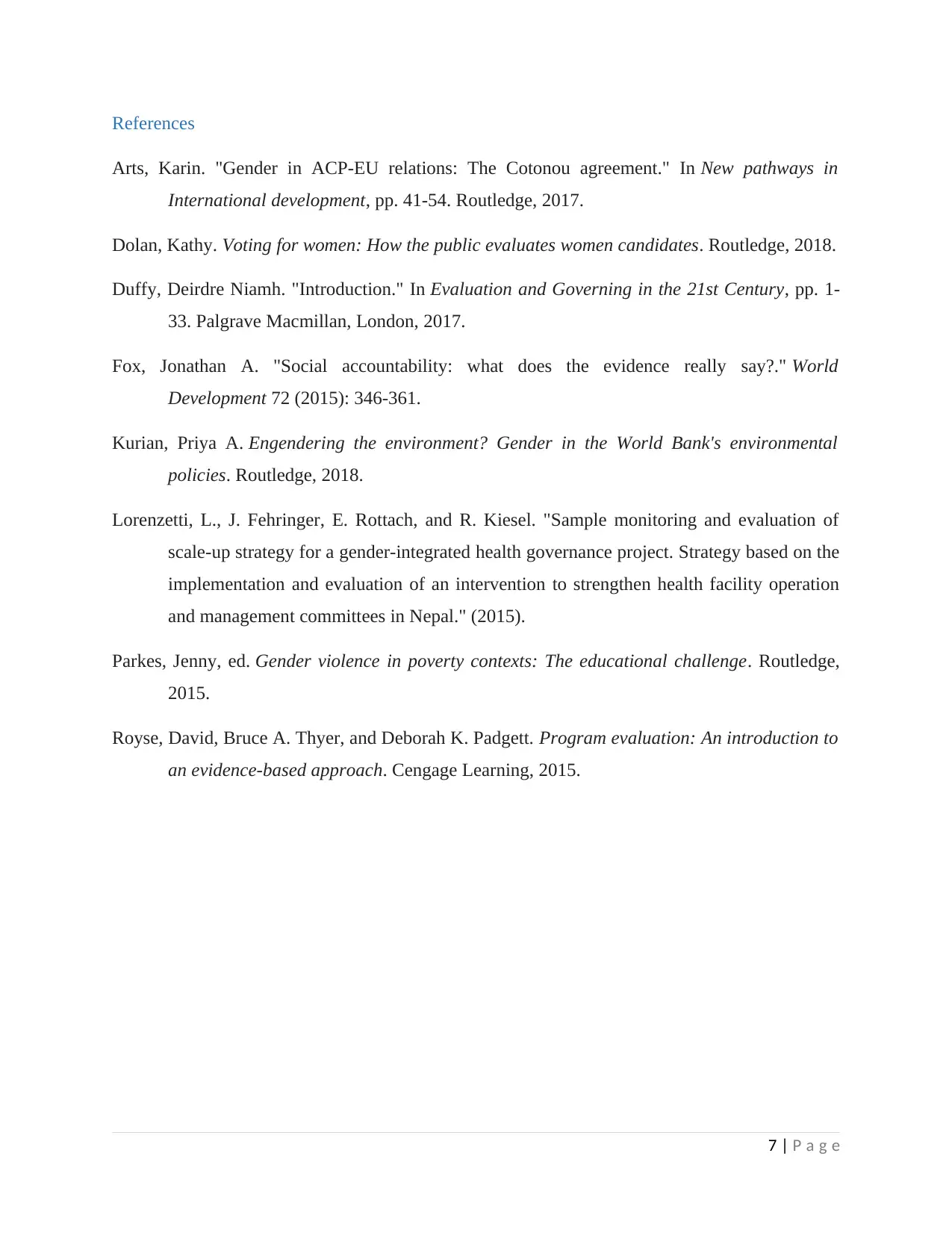
References
Arts, Karin. "Gender in ACP-EU relations: The Cotonou agreement." In New pathways in
International development, pp. 41-54. Routledge, 2017.
Dolan, Kathy. Voting for women: How the public evaluates women candidates. Routledge, 2018.
Duffy, Deirdre Niamh. "Introduction." In Evaluation and Governing in the 21st Century, pp. 1-
33. Palgrave Macmillan, London, 2017.
Fox, Jonathan A. "Social accountability: what does the evidence really say?." World
Development 72 (2015): 346-361.
Kurian, Priya A. Engendering the environment? Gender in the World Bank's environmental
policies. Routledge, 2018.
Lorenzetti, L., J. Fehringer, E. Rottach, and R. Kiesel. "Sample monitoring and evaluation of
scale-up strategy for a gender-integrated health governance project. Strategy based on the
implementation and evaluation of an intervention to strengthen health facility operation
and management committees in Nepal." (2015).
Parkes, Jenny, ed. Gender violence in poverty contexts: The educational challenge. Routledge,
2015.
Royse, David, Bruce A. Thyer, and Deborah K. Padgett. Program evaluation: An introduction to
an evidence-based approach. Cengage Learning, 2015.
7 | P a g e
Arts, Karin. "Gender in ACP-EU relations: The Cotonou agreement." In New pathways in
International development, pp. 41-54. Routledge, 2017.
Dolan, Kathy. Voting for women: How the public evaluates women candidates. Routledge, 2018.
Duffy, Deirdre Niamh. "Introduction." In Evaluation and Governing in the 21st Century, pp. 1-
33. Palgrave Macmillan, London, 2017.
Fox, Jonathan A. "Social accountability: what does the evidence really say?." World
Development 72 (2015): 346-361.
Kurian, Priya A. Engendering the environment? Gender in the World Bank's environmental
policies. Routledge, 2018.
Lorenzetti, L., J. Fehringer, E. Rottach, and R. Kiesel. "Sample monitoring and evaluation of
scale-up strategy for a gender-integrated health governance project. Strategy based on the
implementation and evaluation of an intervention to strengthen health facility operation
and management committees in Nepal." (2015).
Parkes, Jenny, ed. Gender violence in poverty contexts: The educational challenge. Routledge,
2015.
Royse, David, Bruce A. Thyer, and Deborah K. Padgett. Program evaluation: An introduction to
an evidence-based approach. Cengage Learning, 2015.
7 | P a g e
1 out of 8
Related Documents
Your All-in-One AI-Powered Toolkit for Academic Success.
+13062052269
info@desklib.com
Available 24*7 on WhatsApp / Email
![[object Object]](/_next/static/media/star-bottom.7253800d.svg)
Unlock your academic potential
© 2024 | Zucol Services PVT LTD | All rights reserved.





